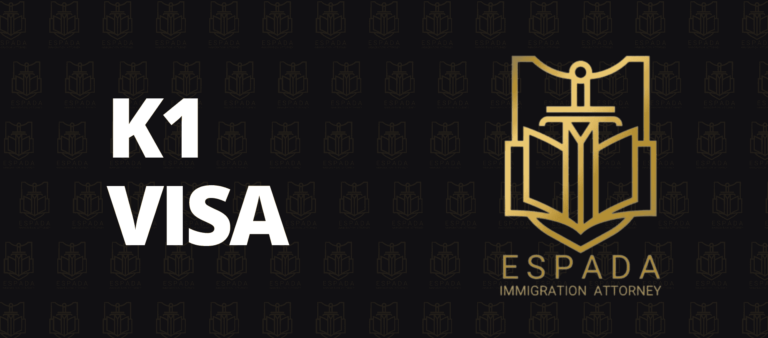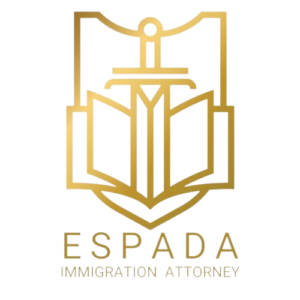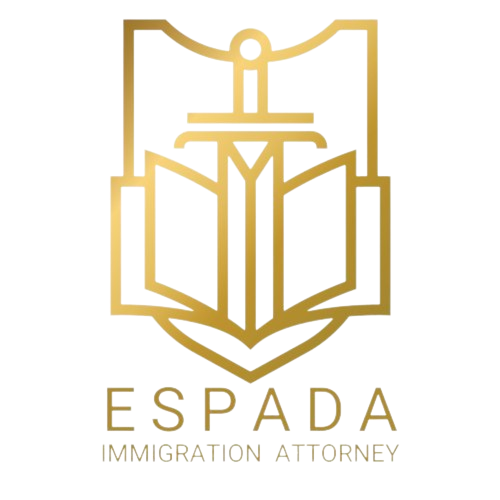K1 Visa Comprehensive Guide : All You Need to Know
K1 Visa Comprehensive Guide : All You Need to Know

The K1 visa, commonly referred to as the fiancé visa, is a specialized visa that allows the fiancé of a U.S. citizen to enter the United States, marry their U.S. citizen partner, and apply for a green card while remaining in the U.S.
This guide covers the key details of the K1 visa. If you have any questions, feel free to reach out to me directly at abbas@espadaimmigration.com. I am quick to respond and would be happy to assist you.
Overview
- What is the K1 Visa?
- What are the Benefits of a K1 Visa?
- K1 Visa Requirements
- K1 Visa Process
- K1 Visa Processing Time
- What are the Documents Required to Get a K1 Visa?
- K1 Visa Form
- K1 Visa Fees
- K1 Visa Interview Questions
- Conclusion
1. What is the K1 Visa?
The K1 visa, commonly known as the fiancé visa, is a specialized visa that enables the fiancé of a U.S. citizen to enter the United States for marriage. After marrying their U.S. citizen partner, the visa holder can apply for adjustment of status to obtain permanent residency (a green card).
To obtain a K1 visa, the U.S. citizen fiancé must file a Form I-129F petition on behalf of their foreign fiancé. The U.S. citizen serves as the petitioner, while the fiancé seeking the visa is the beneficiary.
The process of obtaining a K1 visa can be intricate. Applicants must meet specific eligibility criteria and follow precise steps. Failure to comply with these requirements or properly file the necessary documents could result in significant delays or even denial of the application.
2. What are the Benefits of a K1 Visa?
Eligibility to Adjust Status in the U.S.
One of the primary advantages of a K1 visa is the ability to enter the U.S. for marriage with the intent to adjust status to a green card. The K1 visa requires that the couple marry within 90 days of the fiancé’s entry into the U.S. Following the marriage, the foreign spouse can apply for adjustment of status to become a lawful permanent resident without leaving the U.S.
Ability to Apply for Work Authorization
K1 visa holders can apply for work authorization upon entering the U.S. This is done by filing Form I-765 (Application for Employment Authorization). However, if the work authorization is applied for before marriage, it will only be valid for 90 days from the date of entry.
After marrying the U.S. citizen, the foreign spouse can apply for another work authorization while filing for adjustment of status, allowing for continued employment eligibility.
Immigration Benefits for Children
Unmarried children under 21 years old may qualify for a K2 visa to accompany the K1 visa holder to the U.S. Once the parent marries their U.S. citizen fiancé, the children can also apply for adjustment of status to obtain green cards.
Avoid Filing Form I-130
Typically, obtaining a marriage-based green card requires the U.S. spouse to file a Form I-130, “Petition for Alien Relative.” With a K1 visa, this step is bypassed, allowing the foreign fiancé to file directly for adjustment of status after marriage.
3. K1 Visa Requirements
Petitioner Must Be a U.S. Citizen
Only U.S. citizens can petition for a K1 visa. Lawful permanent residents (green card holders) are not eligible to file for this visa.
Both Parties Must Be Free to Marry
To qualify, both the petitioner and beneficiary must be legally free to marry. This means any prior marriages must be legally terminated.
Intent to Marry Within 90 Days
The K1 visa requires both parties to intend to marry within 90 days of the foreign fiancé’s arrival in the U.S. The U.S. citizen petitioner must submit evidence supporting this intent when filing the initial petition.
Physical Meeting Requirement
The couple must have met in person at least once within the two years prior to filing the K1 visa petition. This requirement is intended to prevent fraudulent relationships, such as “mail-order marriages.”
There are two exceptions to the physical meeting requirement:
Established Custom Exception
If an in-person meeting violates the long-standing customs of the beneficiary’s culture or social practices, this requirement may be waived. Evidence, such as letters from religious or community leaders, should be provided to support this claim.Extreme Hardship Exception
If extreme hardship prevents either party from meeting in person, this requirement can also be waived. Examples of extreme hardship include political instability, financial constraints, medical issues, or travel restrictions. Applicants must submit compelling evidence to substantiate their claim.
4. K1 Visa Process
The K1 fiancé visa application involves several steps. Below is an outline of the process followed by detailed explanations of each step:
- Meeting the K1 Visa Requirements
- Filing Form I-129F by the U.S. Citizen Petitioner
- Submitting Form DS-160
- Attending the K1 Visa Interview
- Entering the U.S. with a K1 Visa (Inspection at Port of Entry)
- Marriage
- Applying for Adjustment of Status
- Attending the Adjustment of Status Interview
Meeting K1 Visa Requirements
The initial step in the process is ensuring you meet the eligibility requirements for the K1 visa. Two critical requirements to focus on include:
Resolution of Prior Marriages: Both you and your fiancé must be legally eligible to marry. Any prior marriages must be legally terminated through divorce, annulment, or the death of a previous spouse.
In-Person Meeting: You and your fiancé must have met in person at least once within two years before filing Form I-129F. If this requirement cannot be fulfilled, ensure you qualify for one of the exceptions mentioned earlier.
Filing Form I-129F by the U.S. Citizen Petitioner
The next step involves the U.S. citizen petitioner submitting Form I-129F, also known as the “Petition for Alien Fiancé(e),” to USCIS. This form establishes eligibility for the K1 visa and must be accompanied by supporting evidence, including:
- Proof of intent to marry within 90 days of entry to the U.S.
- Documentation showing you and your fiancé have met in person within the past two years.
Form I-129F serves as the foundational petition to demonstrate compliance with K1 visa requirements.
Submitting Form DS-160
After USCIS approves Form I-129F, the next step for the K1 visa beneficiary is to complete Form DS-160, the Application for a Nonimmigrant Visa. This form is submitted to the Department of State.
Attending the K1 Visa Interview
The K1 visa beneficiary is required to attend an interview at a U.S. consulate or embassy in their home country. During this interview, they will need to:
- Present all required documents.
- Answer questions about themselves, their U.S. citizen fiancé, and their relationship.
Thorough preparation is essential for a successful interview.
Entering the U.S. with a K1 Visa (Inspection at Port of Entry)
Upon successful completion of the visa interview, the K1 visa beneficiary will receive a valid visa. The next step is to enter the U.S. at a Port of Entry (POE). U.S. Customs and Border Protection officers will conduct an inspection and may ask questions to confirm the purpose of your entry.
Marriage
Once admitted into the U.S., you must marry your U.S. citizen fiancé within 90 days.
Applying for Adjustment of Status
After marriage, the next step is to apply for an adjustment of status to transition from nonimmigrant to permanent resident status (green card). This is done by filing Form I-485, the Application to Register Permanent Residence or Adjust Status, with USCIS.
Requirements for Adjustment of Status
To successfully apply, you must meet the following criteria:
- Legal entry into the U.S.
- Physical presence in the U.S. when filing Form I-485.
- No grounds for inadmissibility under U.S. immigration laws, including criminal history or health-related issues.
Attending the Adjustment of Status Interview
A USCIS officer may schedule an interview as part of the adjustment of status process. During the interview, they will assess the authenticity of your marriage and ensure it is not solely for immigration benefits.
5. K1 Visa Processing Time
The time it takes to process a K1 visa depends on various factors, including:
- USCIS processing times for Form I-129F.
- The workload of the U.S. consulate or embassy where the K1 visa interview will occur.
To check current processing times, you can use the USCIS case status tool. For further assistance, feel free to email me at abbas@espadaimmigration.com.
6. What Documents Are Needed to Obtain a K1 Visa?
Securing a K1 visa requires submitting various documents, which may vary depending on your situation and the evidence available. If you are including documents in a language other than English, ensure they are accompanied by certified English translations. Below is a general list of documents typically required during the Form I-129F stage. It is highly recommended to consult with an experienced immigration attorney to identify the specific documents needed for your case.
Required Documents for Filing Form I-129F:
- Valid U.S. Citizen Passport: Proof of the petitioner’s U.S. citizenship.
- Final Divorce Decrees: Evidence that any prior marriages (for either party) have been legally terminated, if applicable.
- Passport Photos: As required by USCIS guidelines.
- Legal Name Change Proof: If either party has had a legal name change, documentation is required.
- Photo Together: A picture of you and your fiancé together as evidence of your relationship.
- Travel Proof: Flight tickets, itineraries, and passport stamps showing visits to meet your fiancé.
- Statements of Intent to Marry: Signed declarations from both parties confirming the intent to marry within 90 days of the fiancé entering the U.S.
- Communication Records: Phone logs, text message threads, or copies of exchanged letters showing consistent communication.
- Witness Statements: Signed statements from friends or family members attesting to the authenticity of the relationship.
7. Forms Required for the K1 Visa Process
Several forms are necessary throughout the K1 visa application process. Here’s an overview:
Form I-129F: Petition for Alien Fiancé(e)
This is the initial petition filed by the U.S. citizen petitioner with USCIS. It requires supporting evidence of U.S. citizenship, proof of mutual intent to marry within 90 days of the fiancé’s arrival, and proof that the couple has met in person within the last two years.
Form I-765: Application for Employment Authorization
This form can be filed at two stages: upon entering the U.S. on a K1 visa (to seek work authorization before marriage) or during the adjustment of status process.
Form DS-160: Online Nonimmigrant Visa Application
This form is completed and submitted online when applying for the K1 visa. It is a required step before scheduling the visa interview.
Form I-485: Application to Adjust Status
After marriage, this form is filed to transition from non-immigrant status to permanent resident status (green card).
Form G-28: Notice of Entry of Appearance as Attorney or Accredited Representative
If you hire an attorney, this form grants them the authority to represent you, submit applications, and correspond with USCIS on your behalf.
8. K1 Visa Fees
At the time of writing, the K1 visa fees include the following (note that these fees may change, so verify them before filing your application):
- Legal Fees for an Immigration Lawyer: Costs vary depending on the attorney but typically cover the preparation and filing of Form I-129F and representation throughout the process.
- Form I-129F Filing Fee: $535.
- Form DS-160 Filing Fee: $265.
- Form I-485 Filing Fee: $1,225.
- Form I-765 Filing Fee: $410 (if not filed concurrently with Form I-485).
- Medical Examination Fees: Costs vary based on the doctor and location.
- Other Costs: Expenses for document translations, photocopies, and travel may vary depending on your circumstances and country of origin.
9. K1 Visa Interview Questions
During the K1 visa interview, you will face questions to confirm your background, your fiancé’s information, and the legitimacy of your relationship. Below are examples:
Questions About You:
- What is your full name and date of birth?
- Where were you born, and what is your nationality?
- Have you been previously married? If yes, is the marriage officially dissolved?
- Have you visited the United States before? If yes, under what status?
Questions About Your U.S. Citizen Fiancé:
- What is your fiancé’s full name, birth date, and place of birth?
- Where does your fiancé currently live, and what is their occupation?
- Was your fiancé married before? If yes, is the previous marriage legally terminated?
Questions About Your Relationship:
- How and when did you meet your fiancé?
- How often do you and your fiancé communicate?
- Have you met in person? If yes, how many times and where?
- Have you or your fiancé visited each other’s home country?
10. Conclusion
The K1 visa is a unique immigration option that allows the fiancé of a U.S. citizen to enter the United States, get married, and apply for permanent residency. By now, you should have a clearer understanding of the K1 visa’s benefits, requirements, and application process.
If you have additional questions or need further assistance, feel free to email me at abbas@espadaimmigration.com. As an experienced U.S. immigration attorney, I am highly responsive and would be happy to guide you through the K1 visa process.
Why Choose Us
Choosing the right immigration lawyer can make all the difference in achieving your U.S. immigration goals. At Espada Immigration Lawyer, we are dedicated to providing exceptional legal guidance and personalized support through every step of the process. Our team combines specialized expertise, transparency, and an unwavering commitment to client success, making us a trusted partner for all your immigration needs.
- Specialized Expertise
- Personalized Approach
- Transparent Guidance
- Client-Centered Commitment

DISCLAIMER: This article is provided for general informational purposes only and does not constitute legal advice. The information herein should not be interpreted as formal legal counsel nor does it establish an attorney-client relationship. This article is neither intended as a solicitation for legal services nor as a substitute for individual legal advice. For specific legal guidance, please consult an attorney in your jurisdiction. Actions based on information in this article are taken at your own risk, and I disclaim any liability for such actions. Please note that information may have changed since publication and may no longer be current. This article does not offer guarantees, warranties, or predictions regarding the outcome of any legal matters. Each case is unique, and results will depend on individual facts and legal issues. Thank you.
ATTORNEY ADVERTISING: Any invitation to contact our law firm on this website and related pages constitutes attorney advertising.
